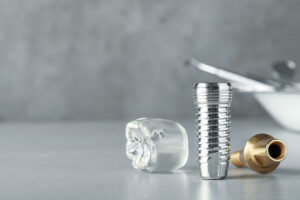The Dos and Don’ts of Managing TMJ Pain
The TMJ is the temporomandibular joint, a point on either side of the face where the jaw connects to the skull. Many people experience symptoms of pain and tenderness in this area. The symptoms are known collectively as temporomandibular joint disorder (TMD).
TMD symptoms can occur on either side of the face or both sides at the same time. Patients often report aching pain of the face or around the ear, tenderness of the jaw and locking of the joint, limiting the range of motion. TMD can make chewing difficult or painful. Another frequently reported symptom is a grinding sound, called crepitus, with movement of the jaw.
It is not entirely clear what causes TMJ disorder. It may be that prolonged pressure on the joints irritates the soft tissues that connect the bones and muscles. Nevertheless, while the cause is not always known, there are things that patients can do the manage the symptoms of TMD. There are also potentially exacerbating factors that should be avoided.
What to do
Managing TMD symptoms typically involves alleviating the pain and relieving the pressure on the jaw. Caring for these symptoms gives the irritation of the soft tissues a chance to resolve itself.
Eat soft foods
Patients should try to avoid foods that are hard or chewy. These foods can strain the TMJ and surrounding tissues. Instead, patients should choose soft foods that do not require much chewing, like mashed potatoes, scrambled eggs and fruit smoothies.
Apply ice and moist heat
Applying ice and moist heat to the area in an alternating fashion can help alleviate pain. Heat can help to relax tight muscles, while ice helps to decrease inflammation. Apply each for only 15 minutes at a time.
Practice relaxation
A patient under stress may clench the muscles of the jaw, which may contribute to TMD symptoms. Relaxation techniques, such as yoga or meditation, may help to relieve the symptoms.
What not to do
Certain habits may contribute to TMD without the patient even realizing it. Breaking these habits may help to improve symptoms. The following are behaviors to avoid.
Sleeping on the stomach
Stomach sleeping can put pressure on the jaw because the position requires the head to turn to one side. The head must then hold this position all night long.
Biting or chewing hard objects
People with TMD should avoid biting or chewing on anything other than food. However, some people compulsively chew on pencils or bite their fingernails. These habits put unnecessary pressure on the TMJ.
Cradling the phone between the ear and shoulder
Some people do hold the phone between the ear and the shoulder to free up their hands, especially when they are at work. However, it forces the jaw into an abnormal position that may put stress on the temporomandibular joint.
Conclusion
Many people ignore TMJ pain or cover it up with pain medications. However, this does not resolve the underlying problem. People with symptoms of temporomandibular joint disorder should see a doctor or dentist right away. These professionals can assess the problem and recommend individualized treatment options.
Request an appointment here: https://www.preferreddentalcenter.com or call Preferred Dental Center at (210) 822-8500 for an appointment in our San Antonio office.
Check out what others are saying about our services on Yelp: Read our Yelp reviews.
Recent Posts
How Can Veneers Improve My Smile?
Only a few people have naturally flawless smiles, which is why treatments like veneers exist. Dental veneers serve as a simple yet effective method of improving the appearance of the smile. Mostly produced from porcelain material, the thin shells are bonded to the front side of the teeth to cover imperfections.To make veneers, the dentist…
Who Is A Good Candidate For All-on-4?
If you have lost your teeth to disease or injury, you have multiple teeth restoration options like All-on-4® dental implants. Replacing lost teeth is essential for proper oral health and function. Since the jawbone, gums and teeth all function as a single system, missing teeth usually have a domino effect, causing further tooth loss, gum…
What Is Sedation Dentistry?
Sedation dentistry allows people who are concerned about potential pain and discomfort to relax during dental procedures. Dental anxiety is common, especially among those who have an unpleasant history with the dentist. Fortunately, there are different sedation dentistry options to give patients a comfortable experience in the dental office.Sedation dentistry involves the administration of a…
Invisalign For Bite Issues
Originally, Invisalign® was only designed to address crookedness, crowding or spacing issues in the teeth. However, over the years, the technology has greatly improved, allowing for advancements when it comes to what issues it can tackle. A common question is whether or not bite issues can be addressed with Invisalign® clear aligners. Each patient is…
Recent Posts
How Can Veneers Improve My Smile?
Only a few people have naturally flawless smiles, which is why treatments like veneers exist. Dental veneers serve as a simple yet effective method of improving the appearance of the smile. Mostly produced from porcelain material, the thin shells are bonded to the front side of the teeth to cover imperfections.To make veneers, the dentist…
Who Is A Good Candidate For All-on-4?
If you have lost your teeth to disease or injury, you have multiple teeth restoration options like All-on-4® dental implants. Replacing lost teeth is essential for proper oral health and function. Since the jawbone, gums and teeth all function as a single system, missing teeth usually have a domino effect, causing further tooth loss, gum…






